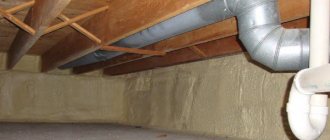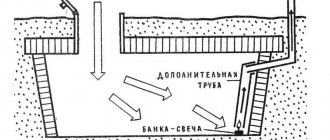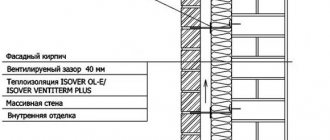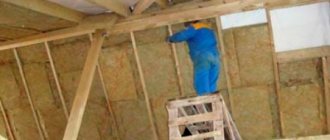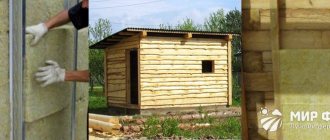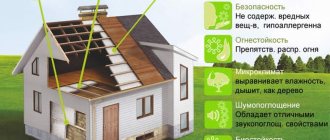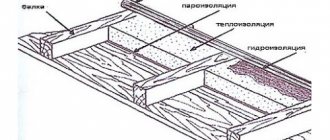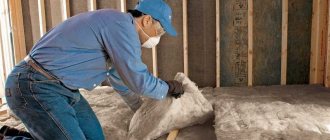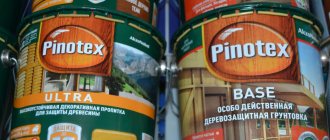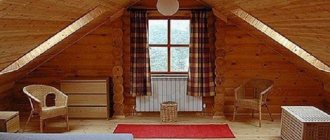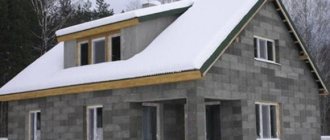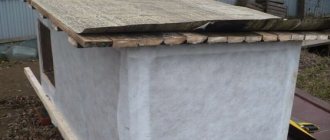Insulation of the dacha
The design of a country house is usually intended to be used during the warm season. The main task is protection from precipitation, wind and dust.
During the cold season, it becomes impossible to live in a country house; it is not able to sufficiently provide a comfortable temperature. You have to constantly heat the stove or boiler, keep electric heaters on, which creates increased consumption of energy, fuel and, accordingly, money.
Let's look at how to insulate a country house for winter living and solve the problem with your own hands.
Why insulate?
Insulating a country house for year-round use automatically turns it into a full-fledged home. The fashion for country houses has been around for quite some time, and insulating a dacha makes it possible to acquire such a home relatively inexpensively and easily. The possibility of year-round living outside the city limits, in the fresh air, is attractive to most owners of country houses.
In addition to considerations of economy, insulating a country house with your own hands has another, more important reason. When people live permanently, the house develops its own atmosphere, saturated with water vapor. They appear due to cooking, using the bathroom, toilet. But the main amount of steam appears due to people's breathing. The steam that comes out of your mouth in the cold is also released when you breathe in warm rooms, it’s just not visible. In the internal atmosphere of a house, steam is under a certain pressure, which is called partial pressure. Normally, this moisture is gradually pressed through the walls and removed outside, evaporating from the outer surface of the walls.
If the structure of the house is not designed for living in winter, the surfaces of the walls are not able to retain heat. They are constantly cold, which causes steam to condense on them. The walls get wet, become saturated with water, freeze on the outside and begin to collapse. Metal elements begin to rust and fail.
Insulating the dacha for winter living will help to avoid this, which consists of installing a heat insulator on the surface of the external walls, ceilings, floor and (if required) roof.
Important aspects
When the house is already ready, and the amount of insulation turned out to be insufficient, then it is worth following a few tips when creating insulation for garden houses:
- Using bulk and mineral insulation, the thickness of the backfill for temperatures not lower than -20 o C should be 10 cm. If the cladding is blown, the figure increases to 15 cm.
- When laying insulation, it must be sufficiently compacted. When clicked, the form should return to its original state. Fine, loose thermal insulation of natural origin is compacted tightly.
- To ensure that the insulation of a garden building for recreation does not result in high costs, you can combine industrial materials with improvised ones. Use good insulation closer to cold sources. When insulating the floor, industrial raw materials will be laid down.
We recommend watching the video: mistakes when insulating a house.
All thermal insulation materials must be dry. At the slightest humidity, the insulation will lose its properties and rot.
After installing a heat-insulating pie, increased humidity may occur in the house, which is provoked by the following conditions:
- Cracks.
- Lack or improper ventilation. Impaired air circulation leads to a lack of air with the subsequent appearance of moisture.
- Poor quality vapor barrier. It does not affect the humidity inside the room so much as it affects the deterioration of the insulation.
Correctly carried out work and timely identification of shortcomings will avoid problems in the future.
Materials for thermal insulation
To insulate the outside of a country house with your own hands, various materials can be used:
- hard (slab). These include polystyrene foam, penoplex, basalt mineral wool, etc.
- roll . In most cases, these are various types of mineral wool, of which there are several dozen.
- sprayed _ Polyurethane foam, ecowool
- bulk . Expanded clay, vermiculite, sawdust, polystyrene foam granules, etc.
The main indicator characterizing a heat insulator is vapor permeability . Exist:
- permeable materials - mineral wool, all loose types, ecowool, etc.
- impermeable types - polystyrene foam, penoplex, polyurethane foam, penofol and other synthetic types of insulators
In addition, important indicators for heat insulators are:
- heat permeability The lower it is, the better the material is able to retain thermal energy.
- ability to burn . Most heat insulators either do not burn at all or are subject to appropriate procedures during manufacture. At the same time, the possibility of combustion may remain. For example, polystyrene foam does not support combustion , since its granules are filled with carbon dioxide. At the same time, a puddle of molten polystyrene burns quite well
- the ability to hold its shape and not change its linear dimensions over time. If the insulator changes size or shape after several years of operation, so-called problems occur. cold bridges that contribute to wet walls and corrosion of metal parts
- high temperature resistance
- resistance to moisture , hygroscopicity. In this regard, mineral wool, which requires the installation of protective films, lags noticeably behind.
- biologically neutral . The insulator must not rot, support the growth of mold or mildew, or support insects or rodents.
The most common are mineral wool and polystyrene foam. This is due to high performance, relatively low cost and availability. Recently, materials made from polyethylene foam have been actively developed, which are absolutely resistant to moisture and biological manifestations.
The choice is usually determined by price and the user’s general ideas about a particular material, its qualities and properties. For those wishing to insulate a country house for winter living, price is of considerable importance , which often predetermines the choice of material to the detriment of the quality of work.
When deciding how and with what material to insulate a country house, you need to take into account the specifics of the operation of a particular insulator and have an idea of the physical processes occurring in the structures of the house.
How best to insulate
There are two ways:
- insulation of a country house from the inside
- insulation of a country house from the outside
External insulation is considered the most effective and preferable option. It consists of installing a heat insulator on the outside of the walls and has many advantages:
- The inner surface of the walls is kept intact , which allows you to finish it in any way, install hanging furniture or household appliances
- all conditions are maintained for the unhindered release of water vapor , the durability and safety of wall materials and structures is ensured
- walls are included in the thermal contour of the building, which contributes to more efficient operation
The disadvantages of external insulation include:
- work cannot be carried out in frost , rain or darkness
- not all types of insulation are suitable for outdoor installation
Insulation from the inside involves installing heat insulators on the inside. The room becomes as if enclosed in a cocoon of insulating material installed on all external walls. The disadvantages of this method are:
- the escape of steam through the walls becomes more difficult or even
- the surface of the walls is covered with insulation, requiring the installation of protective sheathing or another layer
- installation of hanging objects on the walls is excluded
- the volume of rooms is reduced
- external walls are excluded from the thermal contour , remaining only mechanical fences
The advantages include:
- ability to carry out work at any time or in any weather
- there is free access to any surfaces
The main difference between these methods is the steam output mode. With external insulation, it passes through the wall, enters the insulation, from where it is removed outside. It is necessary to use a vapor-permeable insulator, the most successful option of which is mineral wool. With internal insulation, steam escape becomes almost impossible. If an impermeable insulator is used, cutoff occurs. If mineral wool is installed, then the steam passing through it ends up in front of the wall. Its permeability is lower than that of the insulator, so steam accumulates in the thickness of the insulation, the material becomes wet and loses its working qualities.
Vapor permeability rule
There is a rule according to which the vapor permeability of materials should increase in the direction from inside to outside. According to him, installing an impermeable insulator on the outside will “lock” the vapors inside the wall, causing it to become wet and begin to deteriorate.
At the same time, installing permeable material on the inside will create conditions for vapor absorption by the insulator, but will prevent passage through the wall. Guided by this rule, you can avoid common mistakes when choosing and installing heat insulators.
When choosing an installation method, you should definitely prefer the outdoor option. However, sometimes you have to choose internal insulation if there is no possibility or access to the surface of the walls. For example, you cannot disturb the architecture of the house, or the walls are located too close to the neighboring building, etc. When choosing internal insulation , you should immediately take care of creating a high-quality ventilation system . The removal of internal air will remove steam, which will eliminate the problem of excessive air humidity.
Insulation technology
Installation methods for different materials have their own characteristics, but the general procedure remains the same. In addition to vapor permeability, it is necessary to take into account the material of the walls and ceilings in order to select the most suitable thermal insulator. In addition, insulating the walls of a country house will not completely solve the problem.
It will also be necessary to insulate the floor in the dacha from below or above, as well as insulate the ceiling and, if necessary, the roof. Typically, an insulator is installed on the roof in order to make the attic a full-fledged living space.
All work is carried out after appropriate preparation, which consists of removing hanging elements, brackets and other foreign parts from the surfaces. Contaminants are cleaned, crumbling or peeling areas are completely removed. The old coating or layer of paint is removed, if possible.
Gaps or cracks are sealed with putty or solid plaster. After this, the surface is covered with a double layer of deep penetration primer, after which you can proceed to the direct installation of the insulation.
Insulation of floors on the ground
Do-it-yourself floor insulation in a country house is done in accordance with the material or design of the floor slab. Country houses are usually built with floors laid at a low height above ground level or, as they say, on the ground. The proximity to the soil creates high humidity at the lower level of the house; the floor surface is constantly cold, which contributes to moisture condensation.
When insulating the floor in a dacha with your own hands on the ground, you must sequentially perform the following steps:
- remove boardwalk and joists
- level the base soil, compact it
- pour a layer of sand about 20 cm (thickness depends on the level of the floor, existing or desired)
- pour a layer of crushed stone, compact it well, add 305 cm of sand and also compact it tightly
- lay geotextiles and a layer of vapor barrier film on top of it
- lay a layer of insulation. Optimally - extruded polystyrene foam (penoplex), but also a good option is insulating the floor in the country house with expanded clay. It is poured in a layer of 20 cm
- pour a layer of screed 5 cm thick or more, depending on the desired floor level
After the screed has dried, either the floor covering is laid or a heated floor is installed.
Ceiling above the basement and attic
Insulation of the floor in a country house located above an unheated basement is best done from below, from the subfloor side.
A layer of vapor-permeable insulation (mineral wool) is installed on the surface of the prepared floor slab. Since the insulator will need to be protected from moisture , you will first need to install lathing with a thickness of bars no less than the thickness of the heat insulator. The sheathing pitch (the distance between adjacent planks) corresponds to the width of the insulation.
The gaps are tightly filled with insulator , all cracks are filled with polyurethane foam. Then a layer of vapor-waterproofing membrane is installed with the exit down (to the basement), after which you can begin installing the sheathing.
It is optimal to insulate the ceiling of a country house from the outside, from the attic.
The best way is to install high sheathing, fill the resulting cells with expanded clay , and lay plank flooring that allows you to move freely around the attic. It's inexpensive and fast. Alternatively, you can lay a layer of mineral wool.
The use of polystyrene foam or penoplex is allowed only if the attic is residential and heated. Otherwise, the ceiling will get wet and rot.
Wall insulation
There are two ways to insulate the walls at your dacha yourself - from the inside or the outside. We have already examined the advantages and disadvantages of these methods; now we will determine the procedure.
Preparation
Work on insulating the facade of a dacha from the outside begins with preparation - cleaning the walls of all foreign elements, removing cladding or old coating, crumbling or peeling areas. Detected cracks or potholes must be puttied or plastered; the surface is primed with a double layer of primer (deep penetration primer).
Lathing
After this, you need to install the sheathing. First, the outermost vertical strips are installed, aligned vertically and by distance from the wall surface. Then control cords are stretched between them, along which the remaining strips are installed in increments equal to the size of the insulation.
Installation of insulation
Slabs or cut pieces of insulation (mineral wool) are inserted between the sheathing strips. A layer of vapor-waterproofing membrane is installed on top of the insulator with moisture escaping to the outside (you must carefully monitor which side the film is unfolded).
Then horizontal strips for the lining are installed or siding is installed.
Internal option
Insulating a country house from the inside with your own hands is somewhat easier. Heat insulating boards (foam plastic or penoplex) are glued onto the prepared surface of the external wall . As an adhesive composition, you can use a mixture for laying ceramic tiles. The insulator is glued and additionally fixed with special dowels with a wide plastic washer.
After installing the insulation, a reinforcing mesh is attached to its surface with brackets and a layer of plaster is applied.
Mansard roof
If you need to create a full-fledged living space from the attic, you need to insulate the roof. The only available option is to insulate the attic roof from the inside. To do this, you need to install a heat insulator on the lathing layer that supports the roof covering.
A sheathing is installed, between the slats of which heat insulation mats are inserted. It is recommended to use impermeable types of material. All cracks are filled with polyurethane foam. After installing the insulator, sheathing made of clapboard, OSB, chipboard or plywood is installed on the ribs of the sheathing. The choice depends on the type of interior decoration of the attic, since sheet materials allow for more finishing options than lining.
Installation technology
The technology for installing roll insulation is slightly different from slabs. They begin to insulate the walls or floor initially. The walls are mainly made of slabs, as is the straight ceiling. Therefore, often, floors and pitched ceilings-walls are suitable for insulation and installation. When insulating the floor, it is worth looking at what type of insulation is available.
Insulation in foil is mainly used, but sometimes rolls of insulation are covered with ordinary heat-insulating foil or metal film. The insulation should extend 1 cm away from the walls. This is due to the fact that when temperature changes, the material contracts and expands. The lack of free space in metallized or foil insulation leads to its deformation and damage over time.
Ceiling (pitched) insulation is attached between the rafters, cutting out a little more in order to insert it better between the boards. They are inserted strictly from bottom to top to avoid voids. After installation, the surfaces are clamped with main profiles or boards for application of additional (for example, vapor barrier) materials on top. The work is carried out especially carefully.
